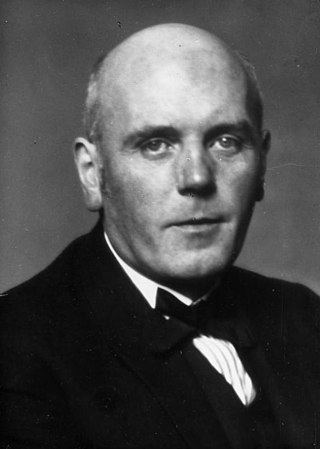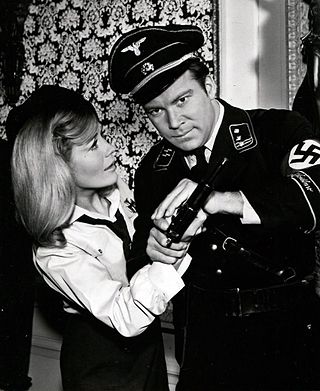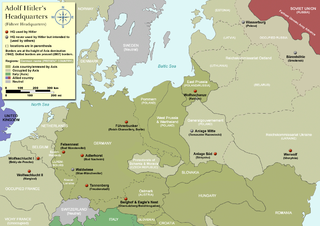
The Nazi Party, officially the National Socialist German Workers' Party, was a far-right political party in Germany active between 1920 and 1945 that created and supported the ideology of Nazism. Its precursor, the German Workers' Party, existed from 1919 to 1920. The Nazi Party emerged from the extremist German nationalist, racist and populist Freikorps paramilitary culture, which fought against communist uprisings in post–World War I Germany. The party was created to draw workers away from communism and into völkisch nationalism. Initially, Nazi political strategy focused on anti–big business, anti-bourgeois, and anti-capitalist rhetoric; it was later downplayed to gain the support of business leaders. By the 1930s, the party's main focus shifted to antisemitic and anti-Marxist themes. The party had little popular support until the Great Depression, when worsening living standards and widespread unemployment drove Germans into political extremism.

The Nuremberg rallies were a series of celebratory events coordinated by the Nazi Party in Germany. The first Nazi Nuremberg rally took place in 1923. This rally was not particularly large and did not have much impact; however, as the party grew in size, the rallies became more elaborate and featured larger crowds. They played a seminal role in Nazi propaganda events, conveying a unified and strong Germany under Nazi control. The rallies became a national event once Adolf Hitler rose to power in 1933, when they became annual occurrences. Once the Nazi dictatorship was firmly established, the party's propagandists began filming them for a national and international audience. Nazi filmmaker Leni Riefenstahl produced some of her best known work including Triumph of the Will (1934) and The Victory of Faith (1933), both filmed at the Nazi party rally grounds near Nuremberg. The party's 1938 Nuremberg rally celebrated the Anschluss that occurred earlier that year. The 1939 scheduled rally was cancelled just before Germany's invasion of Poland and the Nazi regime never held another one due to the prioritization of Germany's efforts in the Second World War.
Führer is a German word meaning "leader" or "guide". As a political title, it is strongly associated with Adolf Hitler, the dictator of Nazi Germany from 1933 to 1945. Hitler officially styled himself der Führer und Reichskanzler after the death of President Paul von Hindenburg in 1934 and the subsequent merging of the offices of Reichspräsident and Reichskanzler.

The Berghof was Adolf Hitler's holiday home in the Obersalzberg of the Bavarian Alps near Berchtesgaden, Bavaria, Germany. Other than the Wolfsschanze, his headquarters in East Prussia for the invasion of the Soviet Union, he spent more time here than anywhere else during his time as the Führer of Nazi Germany. It was also one of the most widely known of his headquarters, which were located throughout Europe.

Paul Ludwig Troost was a German architect. A favourite master builder of Adolf Hitler from 1930, his Neoclassical designs for the Führerbau, the Verwaltungsbau der NSDAP and the Haus der Kunst in Munich influenced the style of Nazi architecture.
This is a list of words, terms, concepts and slogans of Nazi Germany used in the historiography covering the Nazi regime. Some words were coined by Adolf Hitler and other Nazi Party members. Other words and concepts were borrowed and appropriated, and other terms were already in use during the Weimar Republic. Finally, some are taken from Germany's cultural tradition.

"Patterns of Force" is the twenty-first episode of the second season of the American science-fiction television series Star Trek. Written by John Meredyth Lucas and directed by Vincent McEveety, it was first broadcast on February 16, 1968.

Obersalzberg is a mountainside retreat situated above the market town of Berchtesgaden in Bavaria, Germany. Located about 120 kilometres (75 mi) south-east of Munich, close to the border with Austria, it is best known as the site of Adolf Hitler's former mountain residence, the Berghof, and of the mountaintop Kehlsteinhaus, popularly known in the English-speaking world as the "Eagle's Nest". All of the Nazi era buildings were demolished in the 1950s, but the relevant past of the area is the subject of the Dokumentationszentrum Obersalzberg museum, which opened in 1999.

Der Sieg des Glaubens is the first Nazi propaganda film directed by Leni Riefenstahl. Her film recounts the Fifth Party Rally of the Nazi Party, which occurred in Nuremberg, Germany, from 30 August to 3 September 1933. The film is of great historic interest because it shows Adolf Hitler and Ernst Röhm on close and intimate terms, before Hitler had Röhm killed during the Night of the Long Knives on 1 July 1934. As he then sought to remove Röhm from German history, Hitler ordered all known copies of the film be destroyed, and it was considered lost until a surviving copy was found in the 1980s in East Germany.

The Nazi party rally grounds covered about 11 square kilometres (1,100 ha) in the southeast of Nuremberg, Germany. Six Nazi party rallies were held there between 1933 and 1938.

Königsplatz is a square in Munich, Germany. Built in the style of European Neoclassicism in the 19th century, it displays the Propyläen Gate and, facing each other, the Glyptothek and the Staatliche Antikensammlungen. The area around Königsplatz is home to the Kunstareal, Munich's gallery and museum quarter.

Fascist architecture encompasses various stylistic trends in architecture developed by architects of fascist states, primarily in the early 20th century. Fascist architectural styles gained popularity in the late 1920s with the rise of modernism along with the ultranationalism associated with fascist governments in western Europe. Fascist styles often resemble that of ancient Rome, but can extend to modern aesthetics as well. Fascist-era buildings are frequently constructed with particular concern given to symmetry; simplicity; and monumental size, especially for public buildings.

The Documentation Center Nazi Party Rallying Grounds is a museum in Nuremberg. It is in the north wing of the unfinished remains of the Congress Hall of the former Nazi party rallies. Its permanent exhibition "Fascination and Terror" is concerned with the causes, connections, and consequences of Nazi Germany. Topics that have a direct reference to Nuremberg are especially taken into account. Attached to the museum is an education forum.

The Führer Headquarters, abbreviated FHQ, were a number of official headquarters used by the Nazi leader Adolf Hitler and various other German commanders and officials throughout Europe during World War II. The last one used, the Führerbunker in Berlin, where Hitler committed suicide on 30 April 1945, is the most widely known headquarter. Other notable headquarters are the Wolfsschanze in East Prussia, where Claus Graf von Stauffenberg in league with other conspirators attempted to assassinate Hitler on 20 July 1944, and Hitler's private home, the Berghof, at Obersalzberg near Berchtesgaden, where he frequently met with prominent foreign and domestic officials.

A Führer city, or Führerstadt in German, was a status given to five German cities in 1937 by Adolf Hitler, the dictator of Nazi Germany. The status was based on Hitler's vision of undertaking gigantic urban transformation projects in these cities, and executed by German architects including Albert Speer, Paul Ludwig Troost, German Bestelmeyer, Konstanty Gutschow, Hermann Giesler, Leonhard Gall and Paul Otto August Baumgarten. More modest reconstruction projects were to take place in thirty-five other cities, although some sources assert this number was as high as fifty. These plans were however not realised for the greater part because of the onset of the Second World War, although construction continued to take place even in wartime circumstances at Hitler's insistence.

Adolf Hitler's Munich apartment was an apartment owned by Adolf Hitler, located at Prinzregentenplatz 16 in the German city of Munich, the birthplace and capital of the Nazi Party which was formed in Munich in 1920.

Adolf Hitler, dictator of Germany from 1933 to 1945, initiated World War II in Europe with the invasion of Poland in September 1939 and was central to the Holocaust. He was hated by his persecuted enemies and even by some of his own countrymen. Although attempts were made to assassinate him, none were successful. Hitler had numerous bodyguard units over the years which provided security.

Nazi architecture is the architecture promoted by Adolf Hitler and the Nazi regime from 1933 until its fall in 1945, connected with urban planning in Nazi Germany. It is characterized by three forms: a stripped neoclassicism, typified by the designs of Albert Speer; a vernacular style that drew inspiration from traditional rural architecture, especially alpine; and a utilitarian style followed for major infrastructure projects and industrial or military complexes. Nazi ideology took a pluralist attitude to architecture; however, Hitler himself believed that form follows function and wrote against "stupid imitations of the past".

The Reich Harvest Thanksgiving Festival was a monumental Nazi German celebration of the peasantry and the German farmers. The festivals ran from 1933 to 1937 on the Bückeberg, a hill near the town of Hamelin. Most festivals occurred every October, with the 1934 festival commencing 30 September. The official purpose of the festival was the recognition of the achievements of the German farmers, whom the Nazis called the Reichsnährstand. The celebration was also used by the Nazis as a propaganda tool to showcase the connection between Führer Adolf Hitler and the German people. The festival was part of a cycle of Nazi celebrations which included the annual party rally at Nuremberg, Hitler's birthday celebrations and other important events on the Nazi calendar.

Adolf Hitler's cult of personality was a prominent feature of Nazi Germany (1933–1945), which began in the 1920s during the early days of the Nazi Party. Based on the Führerprinzip ideology, that the leader is always right, spread by incessant Nazi propaganda, and reinforced by Adolf Hitler's success in fixing Germany's economic and unemployment problems by remilitarising during the global Great Depression, his bloodless triumphs in foreign policy prior to World War II, and the rapid military defeat of the Second Polish Republic and the French Third Republic in the early part of the war, it eventually became a central aspect of the Nazi control over the German people.

















































